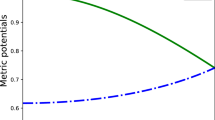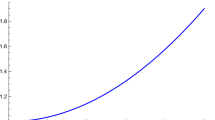Abstract
In static space–time, we solve the Einstein–Maxwell equations. The effective gravitational potential and the electric field for charged anisotropic fluid are defined in terms of two free parameters. For such configurations, the mass of the star as a function of stellar radius is found in terms of two aforementioned parameters subjected to certain stability criteria. For various values of these two parameters, one finds that such a mass–radius relationship can model stellar objects located at various regions of the Hertzsprung–Russel diagram.



























Similar content being viewed by others
References
Ksh Newton Singh et al, Eur. Phys. J. C 77, 100 (2017)
P Mafa Takisa et al, Eur. Phys. J. C 77, 713 (2017)
D Kileba Matondo, S D Maharaj and S Ray, Eur. Phys. J. C 78, 437 (2018)
K N Singh, N Pradhan and N Pant, Pramana – J. Phys. 89: 23 (2017)
P Mafa Takisa and S D Maharaj, Astrophys. Space Sci. 361, 262 (2016)
D Kileba Matondo et al, Astrophys. Space Sci. 362, 186 (2017)
R L Bowers and E P T Liang, Astrophys. J. 188, 657 (1917)
S K Maurya and M Govender Eur. Phys. J. C 77, 347 (2017)
R I Adam and A Sulaksono, AIP Conf. Proc. 1729, 020010 (2016)
S Ray et al, Phys. Rev. D 68, 084004 (2003)
C L Rosen, Astrophys. Space Sci. 1, 372 (1968)
M Gleiser and K Dev, Int. J. Mod. Phys. D 13, 7 (2004)
C W Misner and H S Zapolsky, Phys. Rev. Lett. 12, 22 (1964)
R Garattini and G Mandanici, Eur. Phys. J. C 77, 57 (2017)
D Shee et al, arXiv:1612.05109 (2017)
F Rahaman et al, Eur. Phys. J. C 75, 564 (2015)
R Tikekar et al, Grav. Cosmol. 4, 294 (1998)
K Komathiraj and S D Maharaj, arXiv:gr-qc/0702102v1 (2007)
S Islam et al, Astrophys. Space Sci. 355, 2205 (2014)
S Thirukkanesh and F C Ragel, Astrophys. Space Sci. 352, 743 (2014)
R C Tolman, Phys. Rev. 55, 364 (1939)
M Malaver, Int. J. Mod. Phys. Appl. 2, 1 (2015)
A Einstein, Sitz. Deut. Akad. Wiss. Math. Phys. Berlin 8, 142 (1917)
W de Sitter, Proc. R. Acad. Amst. 19, 1217 (1917)
P Bhar et al, Pramana – J. Phys. 90: 5 (2018)
M Govender and S Thirukkanesh, Astrophys. Space Sci. 358, 39 (2015)
S Thirukkanesh, M Govender and D B Lortan, Int. J. Mod. Phys. D 24, 1550002 (2015)
H Herrera, Phys. Lett. A 165 206, (1992)
M K Mak et al, Europhys. Lett. 55, 310 (2001)
W J Kaufmann, Universe (W H Freeman and Company, USA, 1994)
J B Holberg et al, Astron. J. 135, 1225 (2008)
L James et al, Astrophys. J. 630, L69 (2005)
J L Provencal, Astrophys. J. 494, 759 (1998)
P Kervella et al, Astron. Astrophys. 488, 2 (2008)
S H Pravdo et al, Astrophys. J. 700, 623 (2009)
‘The one hundred nearest star systems’, RECONS. Georgia State University, archived from the original on 2012-05-13, retrieved 2010-06-30
J L Linsky et al, Astrophys. J. 455, 670 (1995)
J Tomkin and Daniel M Popper, Astron. J. 91, 6 (1986)
M Güde et al, Astron. Astrophys. 403, 155 (2003)
F Crifo et al, Astron. Astrophys. 320, L29 (1997)
P Kervella et al, arXiv:astro-ph/0309784 (2003)
L Casagrande et al, Astron. Astrophys. 530, A138 (2011)
J Fernandes et al, Astron. Astrophys. 338, 455 (1998)
M Stix, The Sun: An introduction (Springer, Berlin, 1991), corrected second print
H Bruntt et al, Mon. Not. R. Astron. Soc. 000, 1 (2010)
J Liebert et al, Astrophys. J. 630, L69 (2005)
E J Shaya and P Olling Rob, Astrophys. J. 192, 2 (2011)
A P Hatzes et al, Astron. Astrophys. 457, 335 (2006)
M Aurière et al, Astron. Astrophys. 504, 231 (2009)
T Shenar et al, Astrophys. J. 809, 135 (2015)
P Cruzalébes, Mon. Not. R. Astron. Soc. 434, 437 (2013)
I Ramírez and A C Prieto, Astrophys. J. 743, 135 (2011)
K Ohnaka Astron. Astrophys. 533, A3 (2013)
J Zorec et al, Astron. Astrophys. 441, 235 (2005)
Th Kallinger et al, Proc. Int. Astron. Union 848, (2004)
H R Neilson et al, ASP Conf. Ser. 451, 117 (2011)
M Dolan Michelle et al, Astrophys. J. 819, 7 (2016)
B Arroyo-Torres et al, Astron. Astrophys. 554, A76 (2013)
M Wittkowski et al, Astron. Astrophys. 540, L12 (2012)
D E Beck et al, Astron. Astrophys. 523, A18 (2010)
S M White et al, Astrophys. J. Suppl. 71, 895 (1989)
M Zechmeister et al, Astron. Astrophys. 491, 531 (2009)
Acknowledgements
SI is thankful to P Tarafdar of S.N. Bose National Centre for Basic Sciences for providing some useful insights in the paper. SD is thankful to his sister Nibedita Datta for useful discussions about the cubic polynomial appearing in the paper and he is also thankful to his colleague Md. A Shaikh for helping him with the plots. TKD acknowledges the support from the Physics and Applied Mathematics Unit, Indian Statistical Institute, Kolkata, India, in the form of a long-term visiting scientist (one-year sabbatical visitor).
Author information
Authors and Affiliations
Corresponding author
Rights and permissions
About this article
Cite this article
Islam, S., Datta, S. & Das, T.K. A parametric model to study the mass–radius relationship of stars. Pramana - J Phys 92, 43 (2019). https://doi.org/10.1007/s12043-018-1704-0
Received:
Revised:
Accepted:
Published:
DOI: https://doi.org/10.1007/s12043-018-1704-0
Keywords
- General relativity
- relativistic star
- electric field
- gravitational potential
- a–b parameter space
- stars Hertzprung–Russel diagram




